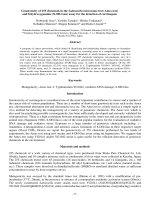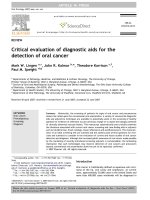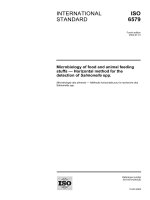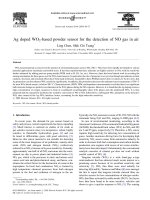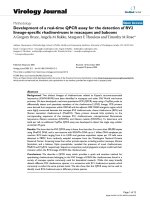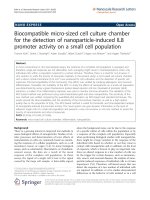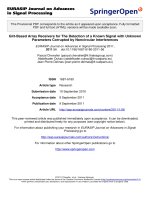optimized rtpcr assay for the detection of infectious myonecrosis virus (imnv)
Bạn đang xem bản rút gọn của tài liệu. Xem và tải ngay bản đầy đủ của tài liệu tại đây (828.79 KB, 46 trang )
CAN THO UNIVERSITY
COLLEGE OF AQUACULTURE AND FISHERIES
Department of Aquatic Pathology
OPTIMIZED RT-PCR ASSAY FOR THE DETECTION OF
INFECTIOUS MYONECROSIS VIRUS (IMNV)
By
NGUYEN KHANH LINH
A thesis submitted in partial fulfillment of the requirements for
the degree of Bachelor of Aquaculture
Can Tho, December 2013
CAN THO UNIVERSITY
COLLEGE OF AQUACULTURE AND FISHERIES
OPTIMIZED RT-PCR ASSAY FOR THE DETECTION OF
INFECTIOUS MYONECROSIS VIRUS (IMNV)
By
NGUYEN KHANH LINH
A thesis submitted in partial fulfillment of the requirements for
the degree of Bachelor of Aquaculture Science
Supervisor
Dr. TRAN THI TUYET HOA
Can Tho, December 2013
i
ACKNOWLEDGEMENT
First of all, I would like to express special thanks to my supervisor, Dr. Tran Thi
Tuyet Hoa for her invaluable guidance, advice, and encouragement. I would also like
to dedicate my great appreciation to Ms. Tran Thi My Duyen and Ms. Tran Viet Tien
for her kind help in finishing the research.
Many thanks are also given to all other doctors of the college of aquaculture and
fisheries, and especially to those of the department of aquatic biology and pathology
for providing me with great working and learning conditions.
I would love to express my sincere appreciation to many of my friends, especially
Duong Thanh Long, Hong Mong Huyen, Tran Thanh Can and Le Tan Hieu for their
unconditionally kind help throughout the experimental period.
Last but not least, I really want to thank my academic adviser, Dr. Duong Thuy Yen,
who was guiding and encouraging me over the last four years, and my family for their
great lifetime support which makes everything possible for me.
The author,
Nguyen Khanh Linh
ii
APPROVE BY SUPPERVISOR
The thesis “Optimized RT-PCR assay for detection of Infectious myonecrosis virus”
which edited and passed by the committee, was defended by Nguyen Khanh Linh in
27/12/2013
Student sign Supervisor sign
Nguyen Khanh Linh Tran Thi Tuyet Hoa
iii
ABSTRACT
The purpose of this study is aim to apply RT-PCR procedure (OIE, 2009) for
detection of Infectious myonecrosis virus on Penaeus vannamei. The procedure was
amplified positive band at 328 bp in the first step and 139bp in the nested-step. The
research was focused to optimize the nested-step with components reaction as 1X
PCR buffer; 1.0mM MgCl
2;
200µM dNTP mix; 0.465µM primer NF and 0.465µM
primer NR; Taq polymerase 2.0U; 0.5µl template (cDNA). Thermal cycling PCR
condition consisted of initial denaturation at 95ºC for 2 minutes followed by 35 cycles
of 95ºC for 30 seconds, 65ºC for 20 seconds, 72ºC for 30 seconds, 72ºC for 7 minutes.
Total amplification time is 2 hours 11 minutes. Protocol also showed that the optimal
RNA concentration using in study has given at 200ng/µl and 100ng/µl by sensitivity
test. The specific test was also conducted with common virus in Penaeid shrimp as
Monodon baculovirus, White spot syndrome virus, Infectious hypodermal and
hematopoietic necrosis virus, Gill-associated virus. Besides, shrimp samples showed
white necrotic muscles in the distal abdominal segments were also employed for the
application test.
iv
Table of Contents
ACKNOWLEDGEMENT I
CHAPTER I 1
INTRODUCTION 1
1.1 General introduction 1
1.2 Research objective 1
1.3 Research activities 1
CHAPTER 2 2
LITERATURE REVIEW 2
2.1 Overview global white leg shrimp industry 2
2.2 Overview of white leg shrimp farming in Vietnam 4
2.3 Common diseases in P.vannamei 4
2.3.1 Taura syndrome 4
2.3.2 White spot disease 5
2.3.3 Yellow Head Disease 6
2.3.4 Infectious hypodermal and haematopoietic necrosis disease 7
2.3.5 Infectious myonecrosis disease 8
2.3.6. Diagnostic methods of IMNV 9
2.3.7 Research of IMNV detection by RT-PCR method 10
2.4 Reverse transcriptase-polymerase chain reaction (RT-PCR) 10
2.5 Factors affecting RT-PCR protocol 13
2.5.1 RT primer 13
2.5.2 One-step and Two-step RT-PCR 13
2.5.3 Quantitating the RNA 13
2.5.4. Check the RNA Integrity 13
2.5.5 Sequence of primer 14
2.5.6 Primer annealing 14
2.5.7 Magnesium Concentration 14
2.5.8 Deoxynucleotide triphosphate (dNTPs) 14
2.5.9 Enzyme Taq pol 14
2.5.10 Thermal cycle 15
2.5.11 Primer concentration and DNA concentration 15
v
CHAPTER 3 16
RESEARCH METHODOLOGY 16
3.1 Research place 16
3.2 Materials 16
3.3 IMNV infected shrimp: 16
3.4 RNA extraction procedure: 16
3.5 Determining yield of RNA 17
3.6 cDNA synthesis with Randome Hexamers primer 17
3.7 Amplified components (IMNV detection followed by OIE, 2009) 17
3.8 Electrophoresis 19
3.9 Test result 19
3.10 Determination of detection limit of the RT-PCR 19
3.11 Determination of specificity of the RT-PCR 19
3.12 Amplification of IMNV from clinical samples by the RT-PCR (OIE, 2009) 20
CHAPTER 4 21
RESULTS AND DISCUSSION 21
4.1 IMNV detection using OIE procedure (OIE, 2009) 21
4.2 Optimization of the chemical components and thermal cycles for the RT-PCR
(IMNV - OIE, 2009) 21
4.2.1 Optimization of the chemical components and thermal cycles of first step
(IMNV - OIE, 2009) 21
4.2.2 Optimization of the chemical components and thermal cycles of Nested step
for the RT-PCR (IMNV - OIE, 2009) 22
4.2.2.1 Optimization of the chemical components and thermal cycles of Nested
step for the RT-PCR (IMNV - OIE, 2009) 22
4.2.1.2 Optimization of Taq polymerase concentration 23
4.2.1.3 Optimization of the magnesium concentration and annealing time 24
4.2.1.4 Optimization of the MgCl
2
concentration 26
4.2.1.5 Optimization of the thermal cycles of nested step 28
4.3 Determination of detection limit of the RT-PCR 30
vi
4.4 Determination of specificity of the RT-PCR 31
4.5 Amplification of IMNV from clinical samples by the RT-PCR (OIE, 2009) . 32
CHAPTER 5 33
CONCLUSIONS AND RECOMMENDATION 33
5.1 CONCLUSIONS 33
5.2 RECOMMENDATION 33
REFERENCES 34
vii
List of tables
Table 3.1: Mixture A component 17
Table 3.2: Mixture B component 17
Table 3.3: First step RT-PCR component 18
Table 3.4: Nested RT-PCR component 18
Table 4.1: PCR reagents of nested PCR for the detection of IMNV 22
Table 4.2: PCR reagents of nested PCR for the detection of IMNV (change in Taq
polymerase concentration) 23
Table 4.3: Optimization of RT-PCR assay for the detection of IMNV (magnesium
concentration and annealing time) 24
Table 4.4: Optimization of RT-PCR assay for the detection of IMNV (magnesium
concentration) 26
Table 4.5: Optimization of RT-PCR assay for the detection of IMNV (magnesium
concentration) 26
Table 4.6: Optimization of RT-PCR assay for the detection of IMNV (number of
cycles and final extension time) 28
viii
List of figures
Figure 2.1 World shrimp aquaculture by species from 1991 to 2013 2
Figure 2.2 Shrimp aquaculture in Asia by species: 1991 - 2013 3
Figure 2.3: The template RNA prior to initiating reverse transcription. 10
Figure 2.4: Priming for reverse transcription 11
Figure 2.5: First strand synthesis 11
Figure 2.6: Removal of RNA 12
Figure 2.7: PCR reaction 12
Figure 4.1: Result of 1
st
step of RT-PCR assay for the detection of IMNV 21
Figure 4.2: Result of 2
st
step of RT-PCR assay for the detection of IMNV 22
Figure 4.3: Result of 2
st
step of RT-PCR assay for the detection of IMNV
(change in Taq polymerase concentration) 23
Figure 4.4: Optimization of RT-PCR assay for the detection of IMNV (magnesium
concentration and annealing time) 25
Figure 4.5: Optimization of RT-PCR assay for the detection of IMNV (magnesium
concentration) 27
Figure 4.5a: Magnesium concentration at 1.5mM 27
Figure 4.5b: Magnesium concentration at 1.0mM 27
Figure 4.6: Optimization of RT-PCR assay for the detection of IMNV (number of
cycles and final extension time) 29
Figure 4.7: Detection limit of the RT-PCR with dilution series of extracted RNA in
agarose gel. 30
Figure 4.8: Result of RT-PCR specific test with GAV, TSV, IHHNV, MBV infected
samples 31
Figure 4.9: PCR amplification of IMNV extracted from Penaeus vannamei 32
1
CHAPTER I
INTRODUCTION
1.1 General introduction
Penaeus vannamei is native to the Pacific coast of Mexico and Central and
South America as far south as Peru (Wyban and Sweeny, 1991; Rosenberry, 2002).
This species was commonly cultured because it reaches commercial size in a short
cultured period, and has high economic value and high resistance against diseases.
Vietnam has allowed culturing P.vannamei after removing official ban concerning
possible negative impacts of this species. However, white leg shrimp farming only
actually increases when P.monodon production drops down due to disease and market
demand.
The change from wild life to controlled culture systems can cause many
problems, such as culturing at high density, and environmental degradation, which
facilitate outbreaks of serious disease, especially viral diseases such as Taura
syndrome virus (TSV), Infectious hypodermal and haematopoietic necrotic virus
(IHHNV), and Infectious myonecrosis virus (IMNV).
Infectious myonecrosis virus (IMNV) was found fist in 2004 in Brazil and
second in 2006 in Indonesia. There are anecdotal reports and informations about this
virus as well as treatment for Infectious myonecrosis caused by IMNV. Although
IMNV is a new virus, mortalities from Infectious myonecrosis go up to 70% and
change feed conversion ratios (FCR) from normal value to very high value (Andrade
et al., 2007)
A rapid and sensitive method for definitive diagnosis of the disease was
developed using reserve-transcriptase polymerase chain reaction (RT-PCR) (Poulos,
Lightner, 2006). This method was developed and tested to provide a rapid, sensitive
and specific test to detect IMNV in penaeid shrimp (Poulos et al., 2006)
1.2 Research objective
The research aim to apply a specific and sensitive protocol for the detection of
IMNV from Penaeus vannamei.
1.3 Research activities
This research was conducted two following contents:
Optimization of chemical ingredients of RT-PCR for the detection of IMNV
Optimization of cycling conditions of RT-PCR for the detection of IMNV
2
CHAPTER 2
LITERATURE REVIEW
2.1 Overview global white leg shrimp industry
In the early 1970s, Penaeus vannamei were introduced to Pacific Islands for
breeding and aquaculture. During the late 1970s and early 1980s they were introduced
to Hawaii and the Eastern Atlantic Coast of the Americas from South Carolina and
Texas in the North to Central. They have become the primary culture species in
Ecuador, Mexico, Venezuela, Brazil, and Central America over the past 20-25 years.
Their production in Latin America areas is approximately 576 thousand metric tons,
accounting for 17% of world total of marine shrimp (David, 2010).
Figure 2.1 World shrimp aquaculture by species from 1991 to 2013
3
Figure 2.2 Shrimp aquaculture in Asia by species: 1991 - 2013
Penaeus vannamei was introduced to Asia in the late 1980s. However,
commercial shrimp industry really developed in the early 2000s. Production increases
sharply from 7% in 2001 to 37% in 2003 compared to total aquaculture shrimp
production in Asia (Diego and James, 2011) (Figure 2.2). Production of this species is
approximately 2.7 million metric tons, accounting for 82% of world total of marine
shrimp (David, 2010). China, Thailand, Vietnam, Indonesia, and India are the
countries with the largest shrimp production in Asia areas. Especially, Thailand
converts nearly 100% of its total surface areas of P.monodon to culture white leg
shrimp, becoming the country with top production in South Asia. Mainland China
produces more than 270,000 metric tons in 2002 and estimated 300,000 metric tons in
2003, which is higher than the current production of the whole of the America areas
(Matthew et al., 2004), reaching 1,000,000 metric tons in 2009 (David, 2010). Other
South Asia countries also develop this species industry including Thailand with
120,000 metric tons in 2003, Vietnam and Indonesia with 30,000 metric tons for each
country in 2003 (David, 2010). In 2009, Thailand reached 300,000 metric tons while
production of Indonesia was approximately 250,000 metric tons and higher 150,000
metric tons in Vietnam (Matthew et al., 2004).
Although Asia contributed 37% of total shrimp production in 2003 to 67% in
2011 and world contributed 45% P. P.vannamei production in 2003 to 71% in
2011(Diego and James, 2011). However, both production of Asia and world changed
in this period because of environment degradation as water quality, temperature, high
quality seed, and habitat changed from natural to aquaculture, outbreak diseases.
Especially, viral disease threatens sustainable shrimp industry of worldwide.
4
2.2 Overview of white leg shrimp farming in Vietnam
Penaeus vannamei have been cultured in Thailand, and Indonesia and achieved
high efficiency in late 1990s and early 2000s. However, since June 2002, the Ministry
of Fisheries of Vietnam adopted to culture this shrimp in small scale tests because of
the concern that P.vannamei are capable of transmitting disease to the native shrimp.
Since 2008, the agriculture rural development has allowed the culture of
P.vannamei in farming and immediately white leg shrimp farming quickly spread out
in coastal central areas such as Quang Nam, Quang Ngai, Ninh Thuan, Binh Thuan
and the Mekong Delta. In 2012, areas for P.vannamei farming increased 28,169 ha
(15.5% total area), reaching 177,817 tons (3.2% production) compared to 2011,
accounting for 5.9% cultural areas and 27.3% production. Especially, the Mekong
Delta contributed 77,380 tons, covering 15,727 ha of total area (VASEP, 2012).
Although P.monodon are dominant species of shrimp for the exported industry of
Vietnam, farming areas and production of P.vannamei have increased in recent years.
Both the total farming area and production increased from 1,170 ha and 10,000 tons in
2002 to 4,000 ha and 30,000 tons in 2007. The total farming area reached 8,000 ha in
2008, then to 14,500 ha in 2009 before occupying 25,300 ha in 2010. The North and
the Center areas have 17,960 ha, accounting for 72% of the total farming area, while
the Mekong Delta has smaller areas. Recent year later, farming white leg shrimp area
increase because of high economic value. However, virus outbreak disease damages
shrimp industry cause by culturing at high density and environmental degradation in
short time.
2.3 Common diseases in P.vannamei
In 1989, the first major crash in the production of farmed-raised shrimp was
found in Asia. Further crashes in production threaten shrimp industry, largely due to
viral diseases (FAO, 2004).
Since 1980, at least four viruses were discovered that caused pandemics have
adversely affected the global penaeid shrimp farming industry, those are Infectious
hypodermal and hematopoietic necrosis virus (IHHNV), Yellow Head Virus (YHV),
Taura Syndrome Virus (TSV), White Spot Syndrome Virus (WSSV), and recently is
Infectious Myonecrosis (IMN). These viruses are major causes that seriously impact
the socioeconomic in Asian and American countries. Some reasons are international
trade or movement of infected crustaceans that pose a significant disease threat to
cultured and wild crustaceans.
2.3.1 Taura syndrome
Taura syndrome was a major new disease in P.vannamei farming and was first
described in 1992 in Ecuador. The virus and its viral etiology of TS were confirmed in
1994 and was named Taura syndrome virus (TSV) (Hasson et al., 1995). TSV is
similar infectious cuticular epithelial necrosis virus (ICENV) on the epizootiology of
the disease in Ecuador (Jimenez et al., 2000).
Taura syndrome is simple structural virus, virion was described is a 32 nm
diameter, nonenveloped. icosahedron with a buoyant density of 1.338 g/ml. Its
5
genome includes a linear, positive-sense single-stranded RNA of 10,205 nucleotides,
excluding the 3' poly-A tail, and it contains two large open reading frames (ORFs).
ORF 1 contains the sequence motifs for nonstructural proteins, such as helicase,
protease and RNA-dependent RNA polymerase. ORF 2 contains the sequences for
TSV structural proteins, including the three major capsid proteins VP1, VP2 and VP3
(55, 40, and 24 kDa, respectively) (Bonami et al., 1997; Mari et al., 1998; Mari et al.,
2002; Robles-Sikisaka et al., 2001). Taura syndrome virus replicates in the cytoplasm
of host cells, so the International Committee on Taxonomy of Viruses (ICTV)
assigned this virus in newly genus Cripavirus in new family Dicistroviridae (in the
superfamily of picoranviruses) (Mayo 2002a, 2000b). TSV transmits horizontal by sea
gulls when the latter eat infected shrimp and release feces with infected shrimp
carcasses or pathogen in feces that can lead to rapidly spread out disease from
infectious farming to other areas (Garza et al., 1997; Lightner, 1999). There is still no
more documents that reported Taura Syndrome in wild shrimp since infected wild
shrimps were found near shrimp farm (Lightner et al., 1995). According to Brock
(1997), this disease may not impact wild shrimp population.
2.3.2 White spot disease
White spot disease was first described in East Asia in 1992-1993 and has
become a major economic and ecological threat for global shrimp industry. WSSV is
potentially lethal to most of the commercially cultivated penaeid shrimp species (OIE,
2003). This disease affect seed and broodstock, and quickly dispersed across the Asian
continent to South East Asia and India where it became a major pandemic, and
continues to cause significant losses in some regions. The first report about WSD
outbreaks was from Metanephrops japonicus in Japan in 1993. Although WSD
impacted seriously shrimp farms, mostly in Asia regions, definition and name of
disease has been a complex issue since it was found. The causative agent was named
penaeid rod-shaped DNA virus (PRDV) or rod-shaped nuclear virus of M. japonicus
(RV-PJ).
WSSV has a wide host range among decapod crustaceans (Lo et al., 1996;
Flegel, 1997; Flegel and Alday-Sanz, 1998), and is potentially lethal to most of the
commercially cultivated penaeid shrimp species (OIE, 2003). Negatively stained
virions purified from shrimp hemolymph show unique, tail-like appendages (Wang et
al., 1995). The virions are generated in hypertrophied nuclei of infected cells without
the production of occlusion bodies.
In initial reports, WSSV was described as a non-occluded baculovirus, but
WSSV DNA sequence analysis has shown that it is not related to the baculoviruses
(van Hulten et al., 2001; Yang et al., 2001). There are different isolates resulted in
size of genomes from other studies. The Chinese isolate and Taiwan isolate were
sequenced 305,107 bp (GenBank Accession No. AF332093), 292,967 bp (GenBank
Accession No. AF369029) and 307,287 bp (GenBank Accession No. AF440570)
while a genome size of ~300 kb, a total of 531 putative open reading frames (ORFs)
were identified by sequence analysis, among which 181 ORFs are likely to encode
functional proteins. Thirty-six of these 181 ORFs have been identified by screening
and sequencing a WSSV cDNA library or else have already been reported to encode
6
functional proteins many of which show little homology to proteins from other viruses
(OIE, 2003).
Despite the lack of study and evidence of live shrimp introductions from Asia
to the Americas, WSD had a severe impact on the shrimp industries of both Central
and South America during 1999 (Durand et al., 2000; Vidal et al., 2001; Lightner,
2003). WSSV was diagnosed at several sites in 1995-1997 in captive wild shrimp or
crayfish and in cultured domesticated shrimp stocks in the eastern and southeastern
U.S. (Nunan et al., 1998; Durand et al., 2000; Lightner et al., 2001). Early in 1999,
WSSV was diagnosed as the cause of serious epizootics in Central American shrimp
farms. By mid to late 1999, WSSV was causing major losses in Ecuador and, export
of shrimp in 2000-2001 from Ecuador was down nearly 70% before WSD
(Rosenberry, 2001; Lightner, 2003).
During 1999, WSD also had a severe impact on the shrimp industries of both
Central and South America (Durand et al., 2000; Vidal et al., 2001; Lightner, 2003).
Despite the absence of evidence of live shrimp introductions from Asia to the
Americas, WSSV was diagnosed at several sites in 1995-1997 in captive wild shrimp
or crayfish and in cultured domesticated shrimp stocks in the eastern and southeastern
U.S. (Nunan et al., 1998; Durand et al., 2000; Lightner et al., 2001). Early in 1999,
WSSV was diagnosed as the cause of serious epizootics in Central American shrimp
farms. By mid to late 1999, WSSV was causing major losses in Ecuador (then among
the world’s top producers of farmed shrimp), and by 2000-01, export of shrimp from
Ecuador was down nearly 70% from pre-WSSV levels (Rosenberry, 2001; Lightner
2003). WSSV has been found in wild shrimp stocks in the Americas (Nunan et al.,
2001). In the US, the virus was successfully eradicated from shrimp farms and it has
not been reported from farmed shrimp stocks since 1997.
2.3.3 Yellow Head Disease
Yellow Head Virus is closely related Gill-Associated virus (GAV), and has
been reported from Australian shrimp farms. In laboratory condition, YHV can cause
high mortality in representative cultured and wild penaeid species from the Americas.
American penaeids challenged with YHV did not develop yellow heads or signs of
marked discoloration in laboratory studies (Lightner and Redman, 1998). YHV can
cause high mortality in representative cultured and wild penaeid species from the
Americas (Lu et al., 1994, 1997; Lightner, 1999; Pantoja & Lightner, 2003) in
P.monodon rearing farm.
YHV has enveloped bacilliform virions. They range from approximately 150
nm to 200 nm in length and from 40 nm to 50 nm in diameter and are located within
vesicles in the cytoplasm of infected cells and in intercellular spaces. The virions arise
from longer, filamentous nucleocapsids (approximately 15 nm x 130-800 nm), which
accumulate in the cytoplasm and obtain an envelope by budding at the endoplasmic
reticulum into intracellular vesicles. Negatively stained YHV virions show regular
arrays of short spikes on the viral envelope (Boonyaratpalin et al., 1993;
Chantanachookin et al., 1993; Lightner, 1996a). YHV was originally described
mistakenly as a granulosis-like virus (Boonyaratpalin et al., 1993; Chantanachookin et
al., 1993), but it was later found to be a single-stranded, positive sense RNA (ssRNA)
7
virus (Tang and Lightner, 1999) related to nidoviruses in the Coronaviridae and
Arteriviridae (Sittidilokratna et al., 2002). GAV, the Australian strain of YHV has
been recognized as the type species for the new virus genus Okavirus in the new
family Roniviridae (Mayo, 2002a, 2002b; OIE, 2003). YHD was first described as an
epizootic from Thai shrimp farms (Limsuwan, 1991), and spread out in cultivated
shrimp in many locations in Asia (OIE, 2003). Severe necrosis of the lymphoid organ,
a lesion once thought to be pathognomonic for YHD show that is diagnosis of YHV
(Lightner, 1996a; Lightner et al., 1998; Lightner and Redman, 1998). Frozen imported
commodity shrimp having the same diagnosis was reported in the United States
(Nunan et al., 1998; Durand et al., 2000). However, the diagnosis of YHV infection in
these cases was not confirmed with a second diagnostic method until after the errant
reports were published. A more recent study has shown that the presumptive
histological diagnoses were due to severe infections with white spot virus, which can
cause histopathology in the lymphoid organ which mimics that occurring in severe
acute YHD (Pantoja and Lightner, 2003). YHV is not only harmful frozen commodity
shrimp still remains (Nunan et al., 1998, Durand et al., 2000), but also concurrent
WSSV/YHV infections may occur so RT-PCR and ISH method were using as detail
analyzed one to confirm the presence of YHV.
2.3.4 Infectious hypodermal and haematopoietic necrosis disease
IHHNV is the smallest of the known penaeid shrimp viruses. The virion of this
virus is a 22 nm diameter, having nonenveloped icosahedron with a density of 1.40
g/ml in CsCl. IHHNV has been classified as a member of the Parvoviridae and a
probable member genus Brevidensovirus (Bonami et al., 1990; Bonami and Lightner,
1991; Mari et al., 1993; Nunan et al., 2000) because its genome is linear single-
stranded DNA of 4.1 kb in length, and its capsid consists of four polypeptides with
molecular weights of 74, 47, 39, and 37.5 kD.
The first case of IHHN disease was described as the cause of acute epizootics
and mass mortalities (> 90%) in juvenile and subadult L. stylirostris farmed in super-
intensive raceway systems in Hawaii (Brock et al., 1983; Lightner, 1983, 1988;
Lightner et al., 1983a, 1983b; Brock and Lightner, 1990) in and widely distributed in
cultured shrimp in the Americas and in wild shrimp along the Pacific coast. After that
this disease was found in P.vannamei being cultured at the same facility in Hawaii and
these P.vannamei were shown to be asymptomatic carriers of the virus (Lightner et
al., 1983b; Bell and Lightner, 1984). Some individuals of populations of L. stylirostris
and P.vannamei that survive IHHNV infections and/or epizootics may carry the virus
for life and pass the virus on to their progeny and other populations by vertical and
horizontal transmission (Bell and Lightner, 1984; Lightner, 1996a; Morales-
Covarrubias et al., 1999, Morales-Covarrubias and Chavez-Sanchez, 1999; Motte et
al., 2003). A few years after motality of P.vannamei was reported that not significant
(Lightner et al., 1983b; Bell and Lightner, 1984). However, present ‘runt deformity
syndrome’ (RDS) caused by IHHNV, this syndrome affect growth and economic
value due to small size and not same size. Choosing SPF (specific pathogen-free)
stock is recommended for preventing this disease.
8
2.3.5 Infectious myonecrosis disease
In 2004, Infectious myonecrosis disease (IMN) was reported first in
P.vannamei in Nothern Brazil. This disease is caused by Infectious myonecrosis virus
(IMNV) (Lightner and Pantoja, 2004), with gross signs being necrosis in skeletal
muscle tissues in the distal abdominal segments that are visible as opaque, whitish,
discolorations (Lightner et al., 2004a,b). In 2006, similar signs were reported from
Indonesian shrimp farmers of high mortality. Moribund shrimp exhibited similar signs
to white shrimp infected previously and reported from Brazil (Polous et al., 2006).
Penaeus vannamei is recognized as the definitive host of IMNV by potentially
high mortality in this species. Commonly mortality rates range from 40 to 70% of
populations. However, mortality rates of the Infectious myonecrosis can be up to
100% or increase suddenly after stressful activities. Mortality rates from 35% to 55%
and economic value was estimated to be US$20 million in Brazil (Nunes et al., 2004).
Mortalities range from 40% to 70% in P.vannamei (Andrade et al., 2007).
In the acute phase, infected shrimp often have pathological signs, for example,
part of the skeletal tail muscle necrosis has white opaque discoloration, so the
phenomenon can lead to necrosis and reddened in this muscle. In some cases,
lymphoid organs increase and are 2-4 times bigger than their normal size. IMNV pond
severe infection may die suddenly and lasts for several days. Necrosis of the high rate
of sudden death, usually occurring at or after the time of the operation may be
shocking for example shrimp fishing, salinity or temperature changes suddenly
Some dead shrimp was found after feeding time with full gut.
Although IMN was found in 2004, the damage caused by this disease crash
production of white shrimp as well as revenue threaten the sustaintability of white
shrimp farming worldwide including South American countries, and Asian countries
such as Thailand, Indonesia, and Vietnam. There is anecdotal information about this
disease but there is no effective vaccination as well as no effective chemotherapy.
Mortality rates from 35% to 55% and economic value was estimated to be US$20
million in Brazil (Nunes et al., 2004). Feed conversion ratios (FCR) can increase
from 1.5 up to 4.0 or higher in populations and mortalities range from 40% to 70% in
P.vannamei (Andrade et al., 2007).
IMNV particles are icosahedral in shape and 40 nm in diameter, has non-
enveloped and double-stranded RNA. The genome comprised 7560 nucleotides
containing two open frames include ORF1 and ORF2. In the first half of ORF1locates
RNA-binding proteins and contains s dsRNA-bingding motif in the first 60 amino
acids. A capsid protein was encoded in the second half of ORF1 and determined by
amino acid sequencing. The ORF2 codes putavate RNA-dependent RNA polumerase
(RdRp).
For the above reasons, we need to test larvae prior to stocking in order to limit
the risk of crop and test infectious shrimp which have symptoms of INM disease.
Besides that, keeping temperature, pH, and salinity in farm system; reducing the
amount of food or stop feeding and aeration can prevent disease spread out seriously.
In case a high mortality by disease occurs, water can be treated with 30ppm Chlorine
for some days.
9
2.3.6. Diagnostic methods of IMNV
Only acute-phase Infectious myonecrosis can be presumptively diagnosed from
clinical signs and present behavioural changes. The diseased shrimp which are
infected IMNV become lethargic during or soon after stressful events such as capture
by cast-netting, feeding, sudden changes in water temperature, sudden reductions in
water salinity, etc.). Severely affected shrimp may have been feeding just before the
onset of stress and often have a full gut (OIE, 2012).
Shrimp in the acute phase of Infectious myonecrosis present focal to extensive
white necrotic areas in striated (skeletal) muscles, especially in the distal abdominal
segments and tail fan, which can become necrotic and reddened in some individual
shrimp. These signs may have a sudden onset following stresses: These signs may
have a sudden onset following stresses (e.g. capture by cast-netting, feeding, and
sudden changes in temperature or salinity). Such severely affected shrimp may have
been feeding just before the onset of stress and may have a full gut. Severely affected
shrimp become moribund and mortalities can be instantaneously high and continue for
several days.
When infected shrimp was dissection, the paired lymphoid organs (LO) show
that they are hypertrophied (Lightner et al., 2004; Poulos et al., 2006).
Infectious myonecrosis can can be presumptively diagnosed using histology in
the acute and chronic phases (Bell & Lightner, 1988; Lightner, 2011; Lightner et al.,
2004; Poulos et al., 2006). However, requiring more diagnostic information from
other sources (e.g. history, gross signs, morbidity, mortality, or RT-PCR findings) to
confirm a diagnosis of IMN because some disease has same gross sign of Infectious
myonecrosis such as white tail disease of penaeid shrimp caused by the nodavirus
PvNV (Tang et al., 2007).
By histology using routine haematoxylin–eosin (H&E) stained paraffin sections
(Bell & Lightner, 1988), tissue sections from shrimp with acute-phase IMN present
myonecrosis with characteristic coagulative necrosis of striated (skeletal) muscle
fibers, often with marked oedema among affected muscle fibers. Some shrimp may
present a mix of acute and older lesions.
Significant hypertrophy of the LO caused by accumulations of LO
spheroids (LOS) is a highly consistent lesion in shrimp with acute or chronic-phase
Infectious myonecrosis lesions. Often, many ectopic LOS are found in other tissues
not near the main body of the LO. Common locations for ectopic LOS include the
haemocoelom in the gills, heart, near the antennal gland tubules, and ventral nerve
cord (Lightner et al., 2004; Poulos et al., 2006).
By using wet mount stained or unstained tissue squashes of affected skeletal
muscle or of the LO may show abnormalities. Tissue squashes of skeletal muscle
when examined with phase or reduced light microscopy may show loss of the normal
striations. Fragmentation of muscle fibres may also be apparent. Squashes of the LO
may show the presence of significant accumulations of spherical masses of cells
(LOS) amongst normal LO tubules.
10
The sensitivity was approximately tenfold lower than that of a one-step RT-
PCR assay using the same sample. Other clinical methods such as clinical chemistry,
smear, electron microscopy were not recommended because of not acceptable or not
suitable for research purpose.
2.3.7 Research of IMNV detection by RT-PCR method
All PCR tests have proven to be specific to IMNV. As the sensitivity of the
nested and real-time RT-PCR is greater than any other diagnostic method available
currently, these tests, which approach a detection limit of 10 viral genome copies, are
the gold standard for IMNV (Andrade et al., 2007; Poulos et al., 2006). The molecular
detection of IMNV by in-situhybridisation (ISH), nested RT-PCR and quantitative
real-time qRT-PCR are available published methods (Andrade et al., 2007; Poulos et
al., 2006; Tang et al., 2005). The disease status of all shrimp was also determined by a
combination of PCR tests, histology and in situ hybridization (OIE, 2003). Reverse-
transcriptase polymerase chain reaction (RT-PCR) was noticed as a rapid and
sensitive method for detecting IMNV. The first-step PCR can detect as little as 100
IMNV RNA copies and the two-step PCR can detect in the order of 10 IMNV
RNA copies (Poulos & Lightner, 2006). Sensitivity of the nestedRT-PCR for IMNV
was determined using 10-fold serial dilutions of RNA extracted from purified virions
(Poulos et al., 2006).
2.4 Reverse transcriptase-polymerase chain reaction (RT-PCR)
The polymerase chain reaction (PCR) is a technique for copying a piece of
DNA a billion-fold. As the name suggests, the protocol creates a chain of many
pieces. In this case the pieces are nucleotides, and the chain is a strand of DNA.
The purpose of this method is similar to the PCR except it allows amplification
of small amounts of ribonucleic acid (RNA). RT-PCR is used for detecting viruses
with an RNA genome and RNA transcription (Lon V. Kendall et al., 2000). The
principle RT-PCR protocol is summarized in the figures below.
The template RNA must be isolated from the sample to be tested prior to
initiating reverse transcription (Figure 2.3)
Figure 2.3: The template RNA prior to initiating reverse transcription.
11
Priming for reverse transcription to generate cDNA using the enzyme reverse
transcriptase (RT), a primer is annealed to the template RNA. The primer can be gene
specific primers, random primers or oligo-dT primers for mRNA. In this figure, oligo-
dT primers are used to initiate cDNA synthesis from mRNA. (Figure 2.4)
Figure 2.4: Priming for reverse transcription
The first strand synthesis of cDNA is synthesized using RT. Beginning at the
primer annealing site (A), RT adds complementary nucleotide bases to the mRNA
strand creating a strand of cDNA (B) (Figure 2.5)
Figure 2.5: First strand synthesis
12
The template strand of RNA is removed by treatment with RNAse H. The cDNA can
now be used for amplification by PCR. (Figure 2.6)
Figure 2.6: Removal of RNA
The oligonucleotide primer is allowed to anneal to the template cDNA (A). Taq
polymerase adds complementary nucleotides beginning at the primer annealing site
(B). The resultant product is a double stranded cDNA (C). The three step protocol of
denaturation, primer annealing and extension are prepared to yield a detectable PCR
product (D). The product can be visualized on an ethidium bromide stained agarose
gel following electrophoresis (Figure 2.7)
Figure 2.7: PCR reaction
RT-PCR not only has high sensitivity due to exponential amplification of the
template RNA, very specific when using gene specific primers in the synthesis of
cDNA, but also can be completed in one to two working days, which provides rapid
results
13
2.5 Factors affecting RT-PCR protocol
2.5.1 RT primer
There are three RT primers: oligo dT, random primers, or a gene specific
primer. The most popular primer is OligodT primer so they can get full length copies
of the mRNA. Random primer may use if the message is long (>4kb) or does not have
a poly A tail (prokaryotic mRNA), however, will enable you to transcribe 5′ ends of
long genes, but your cDNAs may not be full length copies of the entire gene. Two
companies that provide an optimized primer including a mix of long random primers
and oligo-dT such as Qiagen QuantiTect Rev. Transcription Kit and the BioRad
iScript Kit. Gene. A primer used for one-step RT-PCR is specific primers enhance
sensitivity by directing all of the RT activity to a specific message instead of
transcribing everything in the mix (Suzanne, 2009).
2.5.2 One-step and Two-step RT-PCR
With a one-step RT-PCR, a sample transfer step is eliminated, eliminating a
potential source for contamination of controls. And with a one-step RT-PCR, because
the primer is gene-specific, the sensitivity may be higher. With two-step RT-PCR, a
larger batch of RNA can be converted to cDNA and then aliquoted into many
reactions. Two-step RT-PCR allows for greater choice in primers and also allows you
to use the same batch of RT for analysis of multiple genes. This will help eliminate a
potential contributor of variation when comparing different genes from the same
source (Suzanne, 2009).
2.5.3 Quantitating the RNA
The yield of RNA can be affected by measuring instrument, contamination
with DNA, contamination with salts, and level of degradation, UV
spectrophotometers. UV is use as popular instrument to meansure the yield.
Advantages of this instrument is not required dilution of the sample and has a very
wide range for measuring RNA, however, UV quantification is that genomic DNA
will also be measured in the sample and if salts or phenol left over from the prep are
contaminating the RNA, then there can also be added absorbance giving a false higher
reading of the RNA. Fluorescent dyes is also used as a good way to prevent
contamination (Suzanne, 2009).
2.5.4. Check the RNA Integrity
RNA quality will have a big impact on the results of cDNA synthesis. And
batch to batch variation in RNA quality will lead to inconsistent results. Running an
agarose gel and check it intact eukaryotic RNA should show a 28s and 18s rRNA with
the larger band looking close to double in intensity compared to the smaller. It is good
if have the same intensity. However, if sample is limitted, the Agilent Bio Analzyer is
also use to determine the quality of RNA (Suzanne, 2009).
14
2.5.5 Sequence of primer
Depending on the species and sequence RNA sequencing, a primer is designed
appropriately for the purpose to minimize errors (Michael A. Innis and David H.
Gelfand, 1990).
Cautions when design primer (Innis and Gelfand, 1991):
- Select the primer sequence has 50% G and C.
- Avoid G and C at the 3 'of the primer because it increases the combined ability
of the two unwanted pairs.
- Avoid primer has similar sequence to prevent primers combine together.
2.5.6 Primer annealing
The temperature and length of time required for primer annealing depend upon
the base composition, length, and concentration of the amplification primers. An
applicable annealing temperature is 4-6°C below the true Tm of the primers, following
the formulation below (Innis and Gelfand, 1990).
This formulation may be changed depending on the experiment.
2.5.7 Magnesium Concentration
The magnesium concentration may affect primer annealing, strand dissociation
temperatures both of template and PCR product, product specificity, formation of
primer-dimer artifacts, and enzyme activity and fidelity. Taq DNA polymerase
requires free magnesium on top of that bound by template DNA, primers, and dNTPs.
Accordingly, PCRs should contain 0.5 to 2.5 mM magnesium over the total dNTP
concentration.
High concentration of magnesium produce non-specific products, while low
concentrations affect DNA synthesis because Mg+ play an important role as co-factor
of Taq-pol. Therefore, magnesium concentration is optimized to ensure efficient
amplification and specificity of PCR products.
2.5.8 Deoxynucleotide triphosphate (dNTPs)
Stock dNTP solutions should be pH 7.0, and common concentration
approximately 10mM (2.5mM of each) can be stored at -20 . Deoxynucleotide
triphosphate concentrations between 20 and 200 µM is better for specificity and
fidelity results. The four dNTPs should be used at equivalent concentrations to
minimize misincorporation errors. Both the specificity and the fidelity of PCR are
increased by using lower dNTP concentrations. Low dNTP concentrations minimize
mispriming at nontarget sites and reduce the likelihood of extending misincorporated
nucleotides (Innis et al., 1988).
2.5.9 Enzyme Taq pol
A recommended concentration range of Taq DNA polymerase is between 1 and
2.5units (SA = 20 units/pmol) (Lawyer et al., 1989) per 100 ul reaction to optimize
PRC protocol. If the enzyme concentration is too high, nonspecific products may
accumulate, and if too low, an insufficient amount of expected product is made.
15
Besides, 0.01% gelatin and 0.1% Trixton X-100 are used for enzyme stability as
buffer.
2.5.10 Thermal cycle
The optimum number of cycles will depend mainly upon the starting
concentration of target DNA when other parameters are optimized. A common
mistake is to execute too many cycles. Too many cycles can increase the amount and
complexity of nonspecific background products. On the other hand, too few cycles
give low product yield (Innis and Gelfand, 1990).
2.5.11 Primer concentration and DNA concentration
Primer concentration and DNA concentration should be equal, if one of these
agents is lack, primer-dimers reaction will occur. Recommended concentration of
primer is 0.1 M after reaction and 10-100 M of DNA in solution (Innis and Gelfand,
1990).

